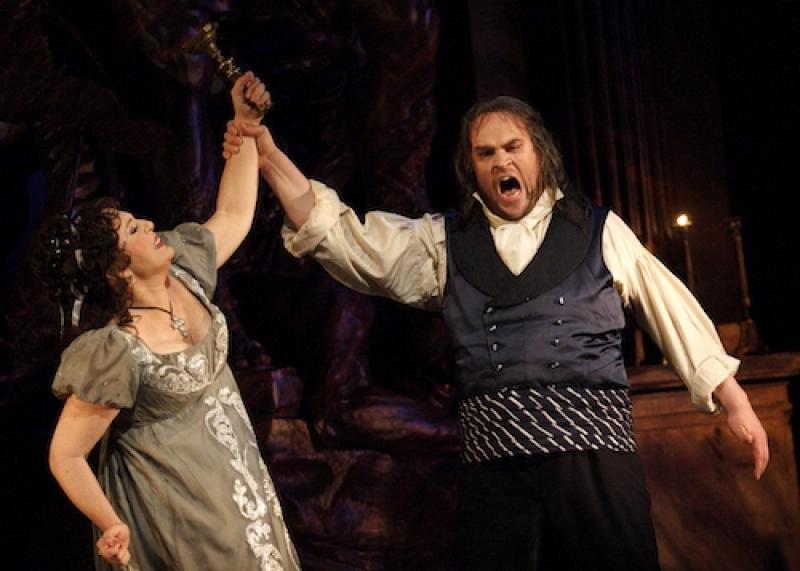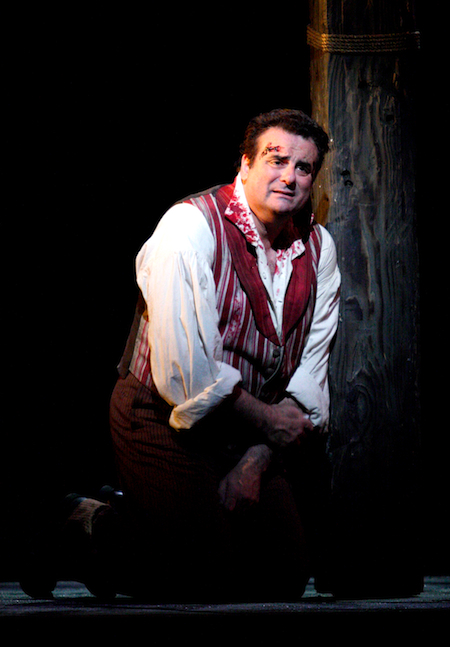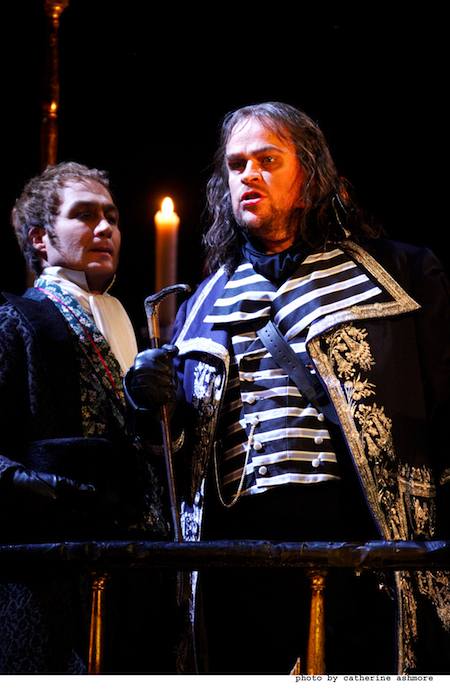Tosca, Royal Opera | reviews, news & interviews
Tosca, Royal Opera
Tosca, Royal Opera
This revival is about a soprano, a tenor, a baritone - Opera with a capital O

Tosca-at-Covent-Garden is a commodity, like bacon-for-breakfast - a pricier commodity, to be true, at officially up to £229.50 a seat, but in both cases people want to get what they expect.
I, like those excitable people who wrote the fascinatingly vivid programme notes about the backstory and original Tosca play, should just take Prozac and calm down. Last night’s production isn’t about ominous, bloody events on the day that Rome’s fate is handed over to Napoleon as revolution blazes over French borders. It isn’t about a jobbing opera singer who mistakenly thinks that she has royal protection against murder and rape, and who trusts in Catholicism even while the Pope is being overthrown. It isn’t about a successful religious painter of woolly liberal sympathies who fails to see that being aristocratic is no defence in anarchical times. It’s about a soprano, a tenor and a baritone, and a couple of nice big Rococo sets and rivers of violins washing seductively under the tunes. It's about Opera with a capital O.
Paul Brown’s set and costumes also come with the capital O. There is a cramped split-level Act I, showing the back view of the high altar and the crypt below it, all gilded bars and railings, nice idea, but not enough space to deliver it; a stunning Act II panelled study for Scarpia, with a monumental Cellini-style David and Goliath bronze statue 20ft high, and a torture chamber behind the only book shelves with any books on; but Act III is a disappointingly unvertiginous flatness under a starry sky. There’s a plethora of candles, setting Mark Thompson the challenge of providing candlelit glows as well as celestial rays, which he expertly surmounts.
 Cavaradossi has an ice-cream seller’s pink-and-white striped waistcoat, Scarpia a vastly over-ornate coat, and Tosca’s gala dress is all boobs, frogs and puff sleeves - on a generous figure I’d think other styling would be possible.
Cavaradossi has an ice-cream seller’s pink-and-white striped waistcoat, Scarpia a vastly over-ornate coat, and Tosca’s gala dress is all boobs, frogs and puff sleeves - on a generous figure I’d think other styling would be possible.
The present cast in this new run of Jonathan Kent’s 2006 production is a warm-up act for the big one in July with Gheorghiu, Kaufmann and Terfel - which will be filmed for cinema release in winter - and it has a few unexciting virtues. Martina Serafin sings Tosca extremely well with a warm, soft-grained Italianate voice and a cuddly femininity that strikes with wholesome innocence and niceness. I find her voice lacks the tragic predilection, the edgy frailty that makes so much more dramatic sense of Tosca’s jealousy, volcanic unreliability and gullibility. Serafin offers a sweet smoothness throughout the voice that last night delivered mixed messages - not least, a very beautiful but disconcertingly gentle “Vissi d’arte” that hardly fits the high-wire horror of the moment she faces.
Actress she doesn’t try to be, at least not for such an intemperate female persona as Tosca. Still less of an actor is her Cavaradossi, Marcello Giordani (pictured left), a rotund old-fashioned Italian tenor with welcome old-fashioned Italian tenor virtues, but with nothing in his imagining of the character to make one see anything about Cavaradossi’s life as a court painter with dangerous friends. Giordani simply concentrates on singing firmly, loudly and with good tone, and not moving about too much.
Astonishingly for this day and age, the production director Duncan Macfarland allows the two stars to stay physically cool and uninvolved, not to say awkward with each other. Serafin sings erotically (and blasphemously) in the chapel of a night of lovemaking she and he might enjoy, and Giordani walked behind her and clutched her feebly through the balustrade of the steps she was sitting on. I snorted with disbelief. In the last few moments God gives them on earth in Act III, they expressed love 12ft apart, turning away from each other as if simply to vary the static look. This truly is antediluvian opera direction, and I can’t imagine Gheorghiu and co will obey the floorplan so docilely.
 The Scarpia is a more interesting case - Finnish baritone Juha Uusitalo makes his Covent Garden debut in challenging circumstances, warming the costume up for Terfel, for whom one supposes the long Napoleonic wig and a hugely ornate coat are designed. Uusitalo’s voice is much lighter in timbre and weight, he is built smaller, and yet he had the sketch of something rather more interesting last night than the other two principals. For one thing his Scarpia felt like a real character - he looked smelly, his hair had a greasy look, the coat was ill-fitting, he swaggered in it clumsily like an ugly man trying to big himself up by dandifying himself. He made you suddenly notice his confession of inadequacy as he menaced Serafin's Tosca: “I have waited a long time for the love of a diva” - none of Gobbi’s immaculate, villainous sexiness here, but a validly repellent reading. (Pictured right, Uusitalo with Hubert Francis as Spoletta)
The Scarpia is a more interesting case - Finnish baritone Juha Uusitalo makes his Covent Garden debut in challenging circumstances, warming the costume up for Terfel, for whom one supposes the long Napoleonic wig and a hugely ornate coat are designed. Uusitalo’s voice is much lighter in timbre and weight, he is built smaller, and yet he had the sketch of something rather more interesting last night than the other two principals. For one thing his Scarpia felt like a real character - he looked smelly, his hair had a greasy look, the coat was ill-fitting, he swaggered in it clumsily like an ugly man trying to big himself up by dandifying himself. He made you suddenly notice his confession of inadequacy as he menaced Serafin's Tosca: “I have waited a long time for the love of a diva” - none of Gobbi’s immaculate, villainous sexiness here, but a validly repellent reading. (Pictured right, Uusitalo with Hubert Francis as Spoletta)
Between Uusitalo’s dramatic subtlety but lightweight voice, and the other two’s big, decent voices but tepid acting, one’s attention was easily drawn to the pit where Antonio Pappano was whipping up a Technicolor melodrama that very nearly made up for the onstage lacunae. Pappano is a richly emphatic colourist in this music, an urgent orator of swoons, starts, tortures and raptures (bouquets to the haunting clarinettist for "E lucevan le stelle"). And yet, when it comes down to why last night’s show was underwhelming, it’s got to come down to him to sort it out.
Explore topics
Share this article
The future of Arts Journalism
You can stop theartsdesk.com closing!
We urgently need financing to survive. Our fundraising drive has thus far raised £49,000 but we need to reach £100,000 or we will be forced to close. Please contribute here: https://gofund.me/c3f6033d
And if you can forward this information to anyone who might assist, we’d be grateful.

Subscribe to theartsdesk.com
Thank you for continuing to read our work on theartsdesk.com. For unlimited access to every article in its entirety, including our archive of more than 15,000 pieces, we're asking for £5 per month or £40 per year. We feel it's a very good deal, and hope you do too.
To take a subscription now simply click here.
And if you're looking for that extra gift for a friend or family member, why not treat them to a theartsdesk.com gift subscription?
more Opera
 BBC Proms: The Marriage of Figaro, Glyndebourne Festival review - merriment and menace
Strong Proms transfer for a robust and affecting show
BBC Proms: The Marriage of Figaro, Glyndebourne Festival review - merriment and menace
Strong Proms transfer for a robust and affecting show
 Orpheus and Eurydice, Opera Queensland/SCO, Edinburgh International Festival 2025 review - dazzling, but distracting
Eye-popping acrobatics don’t always assist in Gluck’s quest for operatic truth
Orpheus and Eurydice, Opera Queensland/SCO, Edinburgh International Festival 2025 review - dazzling, but distracting
Eye-popping acrobatics don’t always assist in Gluck’s quest for operatic truth
 MARS, Irish National Opera review - silly space oddity with fun stretches
Cast, orchestra and production give Jennifer Walshe’s bold collage their all
MARS, Irish National Opera review - silly space oddity with fun stretches
Cast, orchestra and production give Jennifer Walshe’s bold collage their all
 Káťa Kabanová, Glyndebourne review - emotional concentration in a salle modulable
Janáček superbly done through or in spite of the symbolism
Káťa Kabanová, Glyndebourne review - emotional concentration in a salle modulable
Janáček superbly done through or in spite of the symbolism
 Buxton International Festival 2025 review - a lavish offering of smaller-scale work
Allison Cook stands out in a fascinating integrated double bill of Bernstein and Poulenc
Buxton International Festival 2025 review - a lavish offering of smaller-scale work
Allison Cook stands out in a fascinating integrated double bill of Bernstein and Poulenc
 Tosca, Clonter Opera review - beauty and integrity in miniature
Happy surprises and a convincing interpretation of Puccini for today
Tosca, Clonter Opera review - beauty and integrity in miniature
Happy surprises and a convincing interpretation of Puccini for today
 Hamlet, Buxton International Festival review - how to re-imagine re-imagined Shakespeare
Music comes first in very 19th century, very Romantic, very French operatic creation
Hamlet, Buxton International Festival review - how to re-imagine re-imagined Shakespeare
Music comes first in very 19th century, very Romantic, very French operatic creation
 Falstaff, Glyndebourne review - knockabout and nostalgia in postwar Windsor
A fat knight to remember, and snappy stagecraft, overcome some tedious waits
Falstaff, Glyndebourne review - knockabout and nostalgia in postwar Windsor
A fat knight to remember, and snappy stagecraft, overcome some tedious waits
 Salome, LSO, Pappano, Barbican review - a partnership in a million
Asmik Grigorian is vocal perfection in league with a great conductor and orchestra
Salome, LSO, Pappano, Barbican review - a partnership in a million
Asmik Grigorian is vocal perfection in league with a great conductor and orchestra
 Semele, Royal Opera review - unholy smoke
Style comes and goes in a justifiably dark treatment of Handelian myth
Semele, Royal Opera review - unholy smoke
Style comes and goes in a justifiably dark treatment of Handelian myth
 Le nozze di Figaro, Glyndebourne review - perceptive humanity in period setting
Mostly glorious cast, sharp ideas, fussy conducting
Le nozze di Figaro, Glyndebourne review - perceptive humanity in period setting
Mostly glorious cast, sharp ideas, fussy conducting
 Fidelio, Garsington Opera review - a battle of sunshine and shadows
Intimacy yields to spectacle as Beethoven's light of freedom triumphs
Fidelio, Garsington Opera review - a battle of sunshine and shadows
Intimacy yields to spectacle as Beethoven's light of freedom triumphs

Add comment